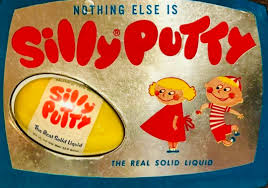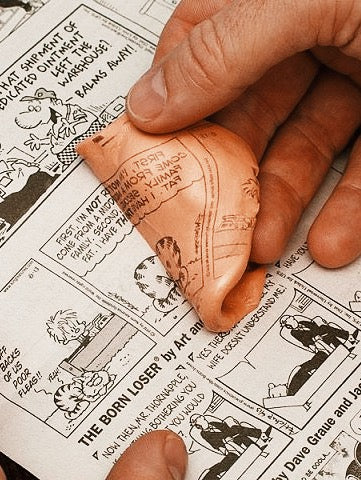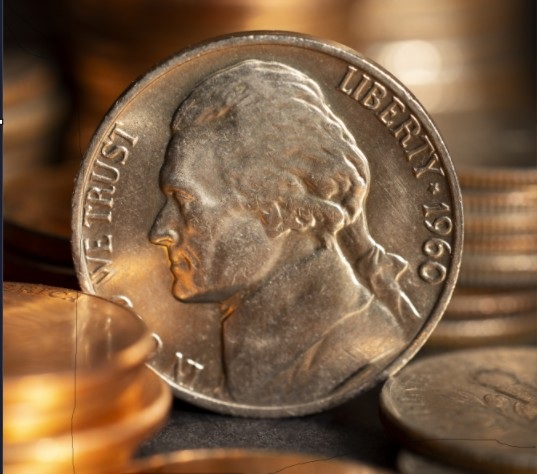Life Lessons from Silly Putty
Mrs. Madona Estep, an accomplished lawyer and passionate supporter of Christian education, presented the following at the annual Student Leadership Conference at Cross Lanes Christian School in February 2025.

Silly Putty is a viscoelastic substance made of silicone polymers. This allows it to behave like a solid if it is manipulated quickly. But if it is left by itself, it slowly flows and takes the shape of its container like a liquid.
It bounces. It stretches with gentle pressure but also breaks with quick pressure. You can copy, manipulate, and transfer pencil drawings from paper.
I'm told it would shatter if you hit it with enough force with a sledgehammer. I'm also told that it is flammable and a good fire starter. But I didn't try those experiments.
So, how did this stuff come to exist, and how long has it been around?
It was invented in 1943, during WWII.
Rubber was one of the most critical materials necessary for World War II. It was used for boots, gas masks, rafts, airplane tires, and other essential military applications.
At that time, rubber primarily came from trees growing in countries along the Pacific Rim (Thailand, Malaysia, Indonesia, Cambodia). Japan, our enemy then, controlled that part of the world.
So, as the war raged on, US rubber supplies ran dangerously low, and the military faced a real problem.
In response, the US government asked major corporations to conduct research into creating a synthetic rubber substitute. This challenge led to contracts with several companies, including General Electric (GE) and Corning Glass. Each of these corporations had chemical engineers working on this project to create a material with the same flexibility and durability as natural rubber, but at a lower cost and with resources that were more readily available than rubber trees in Asia.
During the research, engineers from both companies combined boric acid with silicone oil. Instead of creating the firm, rubbery compound they hoped for, the result was a strange, soft, stretchy material. The story goes that, being frustrated by the failed experiment, one of the engineers dropped the goo on the floor, and to his surprise, it bounced higher than natural rubber.
While this was intriguing scientifically, it did not meet the US military's need for rubber substitutes.
GE sent the material to scientists nationwide to see if anyone could think of a practical use for the substance. No one could. They ultimately determined it was useless. The invention was shelved and might have been completely forgotten had it not been fun to play with.
Some of the folks from GE ended up taking it to a dinner party and showing it to the guests. Among the guests was a woman named Ruth Fallgatter, who owned a toy store, and a marketing executive named Peter Hodgson, who had been working on a catalog for Ms. Fallgatter's toy store.
Ms. Fallgatter decided to try selling the material in her toy store. She called it bouncing Putty and packaged it in a clear box. Although it sold relatively well, Ms. Fallgater lost interest and decided not to continue selling it.
Mr. Hodgson believed the material had value and decided to market it himself. Unfortunately, he was in pretty deep debt at the time, so he had to borrow the money to buy the substance. He borrowed $147 (equivalent to $2000 today) to buy as much of the stuff as he could, and he is the one who decided to name it Silly Putty, trademarking that name. By this time, six years had passed since its invention. It was nearing Easter in 1949. Knowing that a commercial holiday is a good sales hook, he packaged the silly Putty in plastic eggs. He priced each egg at $1 and took his merchandise to the 1950 International Toy Fair in New York City, where he hoped to sell it to retailers.
He came home from the fair with zero sales.
But Mr. Hodgson did not give up. He took his silly putty eggs directly to stores and convinced Neiman Marcus and Doubleday to carry the product. In August 1950, a writer for The New Yorker magazine stumbled across Silly Putty in one of those stores. This writer regularly wrote for a column in the New Yorker called "Talk of the Town." The column focused on cool or interesting new things happening in the city. Fascinated with Silly Putty, the writer mentioned it in his August 26, 1950, column. Sales blew up. It is said that within three days, Mr. Hodgson had received orders for 250,000 eggs full of Silly Putty.
He eventually established a manufacturing plant in his home state of Connecticut and sales and distribution centers in Canada and Europe, creating jobs for many people.
Silly Putty sold faster than any other toy in history, registering over $6 million in sales in the first year.
But Silly Putty's success wasn't without setbacks. The Korean War began around the time Mr. Hodgson's sales started booming. Silicone, a key ingredient in Silly Putty, was in short supply due to the war, and Mr. Hodgson had to stop production, which threatened to destroy his business.
Fortunately, the Korean War ended in 1953, and when the war ended, the restrictions were lifted, and Silly Putty manufacturing resumed. By that point, it had become one of the most popular toys in the country, cementing its place in pop culture history.
By the 1960s, Silly Putty had become popular worldwide and had been sold in Russia and Europe. It even went to the moon with the Apollo 8 astronauts in sterling silver eggs. They took it to alleviate boredom, but the astronauts also found a practical use for it. They used it to fasten down tools in zero gravity.

When Peter Hodgson died in 1976, his estate was worth $140 million, which is the equivalent of $700 million today. In 1977, the parent company of Crayola bought the rights to Silly Putty. According to Crayola, it sells approximately 6 million eggs, or about 90 tons (that's 180,000 pounds), per year.
On May 28, 2001, Silly Putty was inducted into the National Toy Hall of Fame, solidifying its legacy as one of the most beloved toys of all time. It even has a place in the Smithsonian Museum in Washington, DC. Silly Putty is inexpensive, long-lasting, and whimsical.
Despite being 80 years old, it fits perfectly into the modern fidget toy craze.
The medical community has also modified it to help people recovering from hand trauma or stroke. Manipulating the Putty strengthens hand muscles. It is currently in the research phase for a "magnetic slime robot" developed for noninvasive surgery to remove swallowed objects from the digestive tract.
This story demonstrates three essential qualities that a leader must have.
First is the ability to recognize opportunity. Second is the willingness to take risks. Third is resilience in the face of adversity.
A leader must be able to recognize opportunities where others cannot.
Some of the brightest scientific minds at two major corporations were involved in the research that led to the creation of Silly Putty. After it was created, it was shown to many more corporate scientists to see if anyone could come up with a use for the substance. But none of them could.
Ms. Fallgatter, the owner of the toy store, came close to recognizing its potential when she initially sold the substance in her toy store, but she ultimately lost interest and did not pursue it.
It was only Mr. Hodgson who recognized the potential value of what he came to call Silly Putty. Mr. Hodgson did not have any formal education. He spent time in the US Navy in the 1930s and then took a job in advertising. A leader does not have to be the smartest person or the person with the best education, but a leader does have to be able to recognize opportunities where others cannot.
Whether you become an inventor or a business leader, Mr. Hodgson's story reminds us of the importance of being open-minded in our thinking. As a leader, you must remain flexible and look for potential in unexpected results.
A leader must be willing to take risks.
I'm not talking about risky behavior like riding a motorcycle without a helmet, experimenting with drugs, or gambling.
I'm talking about taking a calculated risk after counting the cost.
From the story, Mr. Hodgson was already heavily in debt, but because he believed in the product, he was willing to take a risk and borrow more money to buy his first batch of the substance that would become Silly Putty. His risk paid off. He went from being in debt in 1949 to a net worth of $140,000,000 in less than 30 years. He marketed and sold his product worldwide, likely creating hundreds of jobs for others because he was willing to take risks.
Uncertainty and the fear of failure lurk behind every risk. Taking a risk involves stepping out of your comfort zone and into the unknown. It involves confronting your fear and having faith that everything will work out.
This doesn't mean you should take a blind gamble. You must understand the complexities of the risk involved and the consequences of failure. Only take managed, calculated risks that make sense in relation to your goals.
Finally, resilience is the capacity to adapt to negative change. It is being able to bounce back after failure.
Resilience is a critical element of success.
I'm sure Mr. Hodgson was discouraged when his colleague, Ms. Fallgater, lost interest in the project and stopped selling it in her toy store. But he did not give up. He adapted to this negative change by borrowing money and continuing on his own.
I'm sure that Mr. Hodgson was discouraged when no toy retailers purchased his silly putty eggs at the International Toy Fair. But, he did not give up. He adapted to this negative change by going directly to stores and asking them to stock his product.
Even after he started enjoying success, he had problems that were completely out of his control. Because of the Korean War, he could not get the necessary supplies to continue making Silly Putty. But he did not give up, and eventually, the war ended, and silicone supplies became available again.
While Mr. Hodgson's story is inspiring and a good example of resilience, it is easy to look at someone else's life and say, "Oh, he was resilient." Living it yourself is something very different.
I can't speak to you about resilience without sharing a little of my own story.
Up until age 15, I was a normal, healthy kid who was active and played sports. At age 15, I began having a lot of back pain. After seeing several doctors, I was ultimately diagnosed with an autoimmune disorder called ankylosing spondylitis. This causes arthritis of the spine. During my sophomore year of high school, I required surgery to fuse my first three cervical vertebrae because I was at risk for spinal cord damage and paralysis. Following the surgery, I had to wear a halo brace that was screwed into my skull to keep my neck perfectly still for 4 months while the bones healed. I could not attend school or do any of the active things I used to do.
The procedure was a success in terms of preventing further neck pain or the risk of paralysis, but it left me with a permanently decreased range of motion in my neck. Moreover, even though the surgery was a success, the ankylosing spondylitis did not go away. It began to affect other joints, especially my ankles, making walking difficult and painful. When I was in college, I developed a related condition that impacted my eyes. I had to take high doses of steroids on and off over several years to prevent going blind. Eventually, the steroids took a toll on my body, and my right hip joint collapsed. I had to have hip replacement surgery at age 30. The steroids also caused cataracts. I had cataract surgery on both eyes at age 32. At age 33, I developed a detached retina, which required surgery, and I had to lay on my left side 24/7 for six weeks until it healed. In my early 30s, I had also learned that I would not be able to have children, and I had to have a hysterectomy at age 35. At age 36, a new medication was recommended to me, and I began taking it. In the meantime, I had adopted two children. Thanks to the new medication, my underlying condition went into remission, and I spent the next 17 years living life relatively pain-free with no vision problems. I was a wife and a mom. I was a lawyer and a community volunteer. I hiked, biked, and kayaked. Life was good.
Then, in January 2024, I was doing my usual wife, mom, lawyer, and volunteer thing, and I got sick---really sick----really fast. It was pneumonia. I went into heart failure. I had to have CPR multiple times. I was in the ICU for a month. I had numerous painful procedures. And I had a continuous feeling of not being able to breathe. While I was unconscious, my family was told that my leg may have to be amputated due to loss of blood flow. My family was told I may require a heart transplant. My family was told that I may have brain damage from a lack of oxygen. During that time, I had a stroke. My face drooped. My right eye would not open. I could not smile. I lost 30 pounds. My hair fell out. I suffered from anxiety and depression. All my previous health problems were nothing compared to this illness. And to be honest with you, for many months, I wished that I had died.
It took six months of physical therapy, pulmonary therapy, and psychological counseling to get myself back. I could not have endured without God and the prayers of my family and friends. I am now able to see the good things that came from my ordeal, and I wouldn't change what happened to me. Recovery was a miracle for which I am truly thankful.
Here is the thing. Adversity doesn't discriminate. Bad stuff happens to everyone. If it hasn't happened to you yet, it will. It could be your health, it could be the failure of your business, it could be family disappointments.

But here is the good news: Resilience is not a fixed trait that some people have, and some don't. It is available to us all.
I don't have much video game experience. When I was a kid, Atari was the video game system that everyone wanted. My mom wouldn't let us get one because she said it killed your brain cells. But I was allowed to play it at a friend's house occasionally. We usually played Space Invaders.
When I went to college, my roommate had a Nintendo and we used to play Super Mario Brothers.
When my kids reached the age where they started playing video games, I tried to get into them again, but I didn't enjoy them as much as I did when I was younger.
But here's what I remember from my Super Mario days: My roommate and I would play it until late at night, always trying to reach the next level. Mario would die, which would be frustrating, but we didn't give up. We just started again—over and over and over. It didn't matter that we had an 8:00 class the following day; we just kept trying to make it to the next level.
In video games, failure isn't the end. It's an opportunity to learn, adjust your strategy, and try again. That is the essence of resilience.
My mom was wrong about video games killing your brain cells. Studies show that skills developed in virtual worlds, like the ability to adapt, problem-solve, and persevere, transfer to the real world, helping players navigate challenges in real life.
BUT ALL THINGS IN MODERATION, PEOPLE. Do not spend all your time playing video games.
When you experience an adverse change in your life, don't waste time asking, "Why me?" Don't become bitter because of these negative changes. Instead, hunt for the good stuff. And don't give up.
Proverbs 24:16a says, "Though the righteous fall seven times, they rise again."
That's my prayer for you as future leaders.
If you fall, bounce like Silly Putty. If you are pulled, stretch like Silly Putty. And if you do break, allow God to put you back together like Silly Putty.
Madonna Estep graduated from Dunbar High School as Salutatorian of the class of 1989. From there, she went to Morehead State University where she graduated magna cum laude in 1992 after only six semesters with a Bachelor of Arts degree in Government and French. From there, she went to Washington & Lee University School of Law, which ranked in the top 20 law schools in the country at the time.
Following graduation from law school, Madonna returned to Charleston to practice law with a small firm, where she remained for 28 years. She is admitted to practice before the West Virginia Supreme Court, the Federal District Courts for both the Northern and Southern Districts of WV, the 4th Circuit Court of Appeals, and the United States Supreme Court.
Madonna is married to her high school sweetheart and has 2 children who are current Marshall University students. She is actively involved at Rock Branch Independent Church and enjoys volunteering at CLCS, where she directs the elementary handbell choir.

Eddie Riley
Eddie Riley is the ADMINISTRATOR, SENIOR BIBLE Instructor for Cross Lanes Christian School, and has served in this position since 2013. He has faithfully ministered in Christian Education for over 40 years at schools in NC, AZ, FL, VA, NJ, and WV. Eddie holds a BA in Bible from Bob Jones University, and M.Ed. from West Coast Baptist College
















